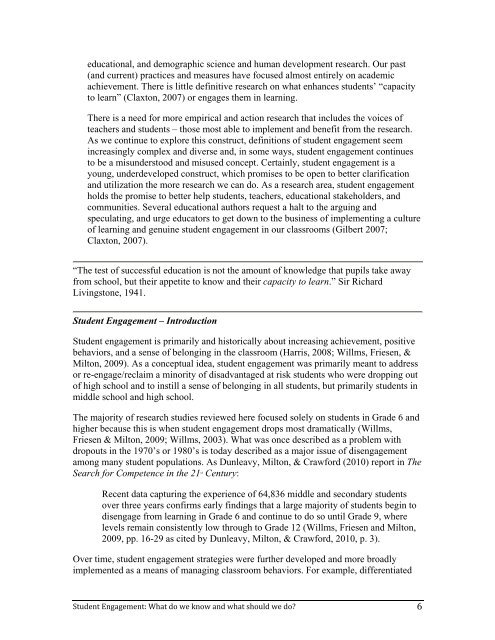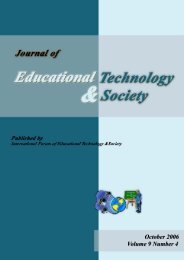Student Engagement: What do we know and what should we do?
Student Engagement: What do we know and what should we do?
Student Engagement: What do we know and what should we do?
You also want an ePaper? Increase the reach of your titles
YUMPU automatically turns print PDFs into web optimized ePapers that Google loves.
educational, <strong>and</strong> demographic science <strong>and</strong> human development research. Our past<br />
(<strong>and</strong> current) practices <strong>and</strong> measures have focused almost entirely on academic<br />
achievement. There is little definitive research on <strong>what</strong> enhances students’ “capacity<br />
to learn” (Claxton, 2007) or engages them in learning.<br />
There is a need for more empirical <strong>and</strong> action research that includes the voices of<br />
teachers <strong>and</strong> students – those most able to implement <strong>and</strong> benefit from the research.<br />
As <strong>we</strong> continue to explore this construct, definitions of student engagement seem<br />
increasingly complex <strong>and</strong> diverse <strong>and</strong>, in some ways, student engagement continues<br />
to be a misunderstood <strong>and</strong> misused concept. Certainly, student engagement is a<br />
young, underdeveloped construct, which promises to be open to better clarification<br />
<strong>and</strong> utilization the more research <strong>we</strong> can <strong>do</strong>. As a research area, student engagement<br />
holds the promise to better help students, teachers, educational stakeholders, <strong>and</strong><br />
communities. Several educational authors request a halt to the arguing <strong>and</strong><br />
speculating, <strong>and</strong> urge educators to get <strong>do</strong>wn to the business of implementing a culture<br />
of learning <strong>and</strong> genuine student engagement in our classrooms (Gilbert 2007;<br />
Claxton, 2007).<br />
“The test of successful education is not the amount of <strong>know</strong>ledge that pupils take away<br />
from school, but their appetite to <strong>know</strong> <strong>and</strong> their capacity to learn.” Sir Richard<br />
Livingstone, 1941.<br />
<strong>Student</strong> <strong>Engagement</strong> – Introduction<br />
<strong>Student</strong> engagement is primarily <strong>and</strong> historically about increasing achievement, positive<br />
behaviors, <strong>and</strong> a sense of belonging in the classroom (Harris, 2008; Willms, Friesen, &<br />
Milton, 2009). As a conceptual idea, student engagement was primarily meant to address<br />
or re-engage/reclaim a minority of disadvantaged at risk students who <strong>we</strong>re dropping out<br />
of high school <strong>and</strong> to instill a sense of belonging in all students, but primarily students in<br />
middle school <strong>and</strong> high school.<br />
The majority of research studies revie<strong>we</strong>d here focused solely on students in Grade 6 <strong>and</strong><br />
higher because this is when student engagement drops most dramatically (Willms,<br />
Friesen & Milton, 2009; Willms, 2003). <strong>What</strong> was once described as a problem with<br />
dropouts in the 1970’s or 1980’s is today described as a major issue of disengagement<br />
among many student populations. As Dunleavy, Milton, & Crawford (2010) report in The<br />
Search for Competence in the 21 st Century:<br />
Recent data capturing the experience of 64,836 middle <strong>and</strong> secondary students<br />
over three years confirms early findings that a large majority of students begin to<br />
disengage from learning in Grade 6 <strong>and</strong> continue to <strong>do</strong> so until Grade 9, where<br />
levels remain consistently low through to Grade 12 (Willms, Friesen <strong>and</strong> Milton,<br />
2009, pp. 16-29 as cited by Dunleavy, Milton, & Crawford, 2010, p. 3).<br />
Over time, student engagement strategies <strong>we</strong>re further developed <strong>and</strong> more broadly<br />
implemented as a means of managing classroom behaviors. For example, differentiated<br />
<strong>Student</strong> <strong>Engagement</strong>: <strong>What</strong> <strong>do</strong> <strong>we</strong> <strong>know</strong> <strong>and</strong> <strong>what</strong> <strong>should</strong> <strong>we</strong> <strong>do</strong>? 6












